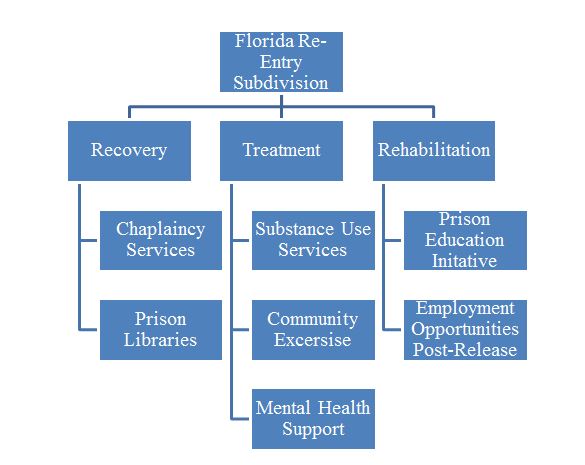Introduction
In this case study, the Florida re-entry subdivision is analyzed as a whole entity that involves three main departments. Firstly, the recovery department is focused on prisoners’ spiritual health. (Florida Department of Corrections, n.d.). The main objectives are to positively influence the individuals’ world perception from an educational perspective by providing chaplaincy services and bookcrossing facilities. Secondly, the treatment department is directly engaged in prisoners’ physical health conditions, which includes substance abuse or addiction analysis, exercising plans, and mental health improvement. Thirdly, the rehabilitation department is responsible for prisoners’ successful integration in social life, which mainly includes job opportunity provision. Even though all the departments have their own objectives and responsibilities, they are united by the main mission, which states “provide a continuum of services to meet the needs of those entrusted to our care, creating a safe and professional environment with the outcome of reduced victimization, safer communities and an emphasis on the premium of life” (Florida Department of Corrections, n.d.). More specifically, they tolerantly urge certain people to reconsider their life perspectives and start being a part of the developed society with its stabilized norms and values. By doing this, the departments distinctly influence their clients not only to perceive and appreciate society’s rules of life but also to adjust personal behavior to become representative members of Florida’s state society.

Focused Mental Health Support Branch Examination
Florida re-entry subdivision specializes in integrating people in social life with its proprieties, rights, and obligations. The specifically analyzed branch is a rehabilitation department is chosen due to certain underestimation of its influence on prisoners’ successful integration. Firstly, the department has a direct responsibility to provide the prisoners with social integration opportunities, which mainly involves help in obtaining permanent jobs. In fact, many sociologists, such as Halushka (2019), state that lack of job opportunities after serving a prison sentence is the main prisoners’ issue that drives them to renew their criminal activity. This situation occurs due to the fact that the society’s negative perception of ancient prisoners’ as regular workers eliminate convicted people’s opportunities to restart living a normal life and integrate into the community. Secondly, the department’s goal is to create the possibilities for prisoners to start the integration process by having the minimum required education for obtaining specific job positions and finding the appropriate business entities which consent to have previously convicted employees (Daquin & Daigle, 2017). Finally, both goals and responsibilities of the recovery department have a direct alignment with the organization’s mission. They provide a qualitative service for convicted people in terms of delivering the appropriate attitude to the individuals, defining their main problems due to the prison sentence, and helping everybody to realize their potential despite the legal and social imitations.
Policies and Mission Alignment
The recovery department has a sophisticated legal organization. However, the main obligations are focused on the job opportunities realization, which plays a critical part in prisoners’ society integration. For instance, the policy of job provision does not guarantee any occupation. Nevertheless, it requires the department to engage maximum resources in finding sufficient professional education for individuals and the employment position that matches the proficiency demands. This policy is indirectly supported by Canadian research that agrees with the statement that by maximizing the efforts, correction-related organization outperforms other private and government entities in successful job-obtaining (Sheppard & Ricciardelli, 2020). This operating procedure has a direct impact on prisoners’ motivation to pursue studies and choose any job opportunities and correctly aligns with the explained and analyzed organization’s mission.
References
Daquin, J. C., & Daigle, L. E. (2017). Mental disorder and victimisation in prison: examining the role of mental health treatment. Criminal Behaviour and Mental Health, 28(2), 141–151. Web.
Florida Department of Corrections. (n.d.). Vision, Mission, Value, and Goals — Florida Department of Corrections. Web.
Halushka, J. M. (2019). The runaround: punishment, welfare, and poverty survival after prison. Social Problems, 67(2), 233–250. Web.
Sheppard, A., & Ricciardelli, R. (2020). Employment after prison: Navigating conditions of precarity and stigma. European Journal of Probation, 12(1), 34–52. Web.
Vaughn, S. (2021). Former Offender Re-Entry Programs and Resources in Florida. Web.